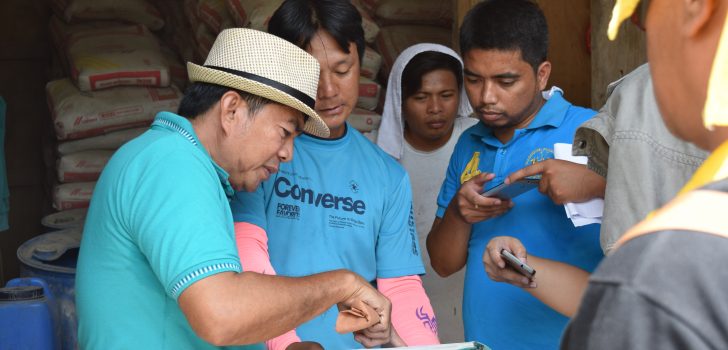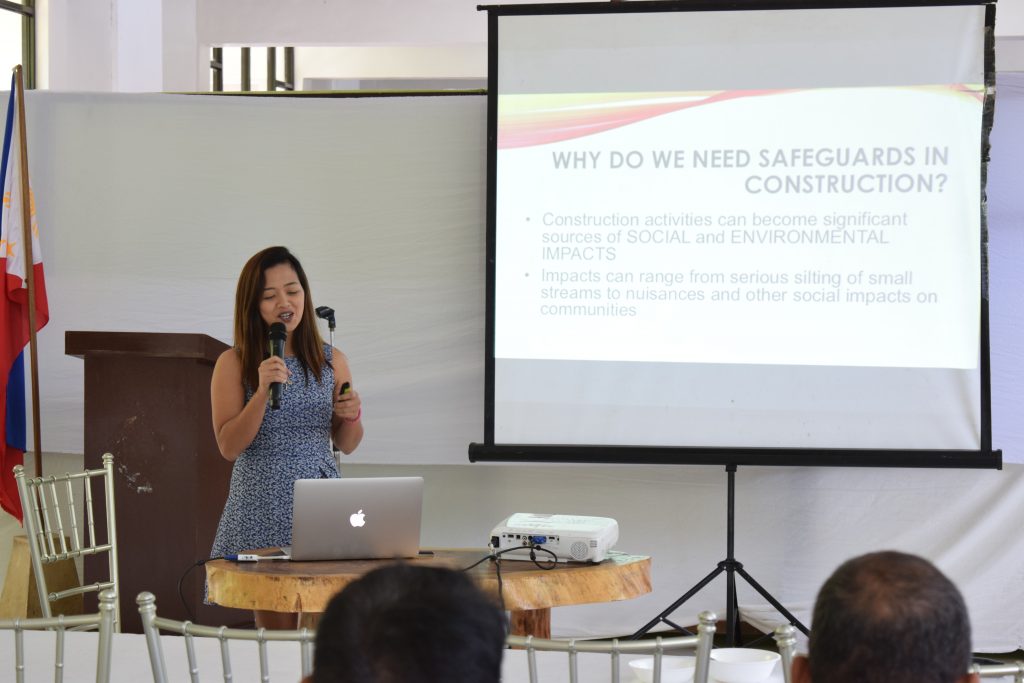 Engr. Chito Tapire of San Antonio, Quezon asks about the Candelaria FMR subproject’s status. He is one of the SES and I-BUILD representatives from Quezon LGUs who participated in the safeguards construction supervision training held on August 8 to 11 in Lucena City.
Engr. Chito Tapire of San Antonio, Quezon asks about the Candelaria FMR subproject’s status. He is one of the SES and I-BUILD representatives from Quezon LGUs who participated in the safeguards construction supervision training held on August 8 to 11 in Lucena City. PRDP mainstreams safeguarding communities and environment, strengthens collaboration with LGUs
Rural development projects do not rely solely on economic growth to be called sustainable. Social inclusiveness and environmental soundness are also key to the projects’ sustainability.
The Philippine Rural Development Project (PRDP) is one of the big projects of the government that aims to deliver holistic and sustainable interventions to rural communities. It also builds on the intention of the World Bank, which is the Project’s primary fund source, to support projects that protect societies and limit harmful effects to the environment.
To ensure that the said measures will be applied during the construction of farm-to-market roads (FMRs), the PRDP’s Social and Environmental Safeguards (SES) unit conducted a training on safeguards construction supervision on August 8 to 11 in CALABARZON. This pilot activity will serve as the basis for similar trainings to be implemented nationwide.
Engineers and safeguard officers from twelve municipalities, cities, and provinces in the region gathered during the four-day workshop to discuss how to monitor and supervise safeguards in the subproject sites. Representatives of the PRDP National Project Coordination Office (NPCO) infrastructure development (I-BUILD) component and SES unit served as the resource speakers.
The basics of safeguards
“We want to impart the knowledge, tools, and applications developed through this Project to those who are in the field and are near where the action is taking place. This will also translate to shared responsibility between the contractor and the community itself,” NPCO SES Unit Head Angelita Martir said.
The SES unit is guided by the Philippine laws and World Bank Operational Policies and standard procedures in identifying and implementing safeguards measures and compliance requirements. The PRDP also developed the Integrated Environmental and Social Safeguards Framework (IESSF) to ensure that safeguards measures are being uniformly implemented by the Project across all subproject areas.
An Environmental and Social Management Plan (ESMP) serves as the backbone of safeguards monitoring and supervision in each subproject site. The specific conditions in each site were incorporated in the ESMP to guarantee that the interventions would be appropriate for the subprojects’ concerns.
Additional plans are prepared if an indigenous community will be affected and if right-of-way, site acquisition, and resettlement of residents are deemed necessary.
Safeguards activities and processes
The training also served as a venue for the local government units (LGUs), especially for the technical staff, to understand the link between infrastructure designs and safeguards. NPCO I-BUILD Alternate Component Head Ericson Mammag discussed the Infrastructure Quality Monitoring and Durability System and how can it also be used as a tool for monitoring safeguards.
The SES unit discussed the environmental and social impacts of the construction and the proper management of the common issues associated with subproject implementation. Some of the issues discussed were pollution concerns, waste management, cultural resources, and labor and human rights.
NPCO Environmental Safeguards Officer Michael Francis Falconi stated, “There are four stages of mitigation hierarchy: avoid, minimize, rectify, and compensate. As much as possible, both the LGU and the contractor must avoid causing any issues. You must also limit problems that will result to compensation as this is the mitigating step of last resort.”
Topics on occupational health and safety, safeguards construction supervision, and compliance monitoring were also discussed.
An important role of the SES unit is on the establishment and management of the grievance redress mechanism (GRM) of the Project. It was emphasized that anyone may report any subproject construction-related concerns to the different offices of the PRDP. Reports will be verified and endorsed to the concerned PRDP office for resolution.

NPCO Social Safeguards Officer Bey de Castro shares the importance of including social and environmental safeguards mechanism in every government project.
Hands-on practice at Candelaria FMR
For the LGU representatives to better understand the concepts discussed and apply what they have learned, the workshop organizers and the participants visited the FMR subproject in Candelaria, Quezon. They went to the field office, barracks, batching plant, and the segments of the FMR.
“This activity will provide our participants guided site inspection, monitoring, and supervision that will be helpful when it’s their turn to do it for their respective sites,” Martir said.
After the field visit, the participants then reported their observations and gave recommendations on what the Candelaria LGU can do to minimize the subproject impacts. “We heard what they have said and we would use their comments as guide [in implementing this subproject]. We may incorporate some of it in our revised ESMP,” SES Focal Person Marian Ada of Candelaria LGU said.
According to Municipal Engineer Chito Tapire of San Antonio, Quezon, the field work and the training as a whole will prepare them for issues that may affect their FMR subproject. The P98.5 million San Antonio FMR subproject has just started its actual implementation and will benefit 2,276 households within its road influence area.
“This will also serve as a proof that the government today is firm [in ensuring] that all projects will not only be built wisely but also conscious with its impacts on the environment and the communities it will serve,” Tapire added. ### (Lawrence Albert Bariring, DA-PRDP CALABARZON RPCO InfoACE Unit)
